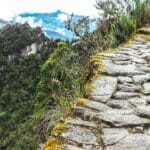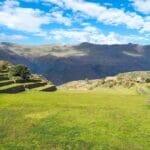Dear reader: This article contains links to products and services that I may be compensated for, at no extra cost to you.
The Inca Trail is a once-in-a-lifetime experience. It is without a doubt one of the world’s greatest hikes and it was at the top of my bucket list for over a decade before I went.
If you’re planning a trip to South America or Peru, chances are the Inca Trail is the one thing you’re going to book and prepare for first, then all your other plans will work around it.
I spent a great deal of time preparing for the Inca Trail. This included researching when to go, how early to book, which trekking company to go with (I went with Sam Travel Peru in the end), clothing & gear, the trail route and famous ruins along it, preparing medications, physical training, and understanding the new circuits at Machu Picchu.
After going through all that, I thought I should share my experience in order to help others through the process. As for the trail itself, I’ve got this separate day-by-day guide to the 4-day Inca Trail, in which I cover exactly what you will see on each day of the hike. Originally I had all of this information in one article, but it became too long so I split it into two!
Since you will almost certainly be passing through Cusco and Lima on the way to the Inca Trail, also see my guide to Cusco, the Cusco Tourist Pass, and how to spend two days in Lima.
Table of Contents
When Is the Best Time to Do the Inca Trail?

The first thing you’ll need to decide when preparing for the Inca Trail is when to do it.
First, you’ll probably want to avoid the rainy season, which USUALLY starts around December and last through to April. And you can’t do the Inca Trail in February, the peak of the rainy season, when they close it. If you don’t mind the rain, though, you’ll find the Inca Trail crowd-free, and lots of pretty flowers bloom at this time.
You may also want to consider avoiding winter in Peru (that’s summer for you North Americans and Europeans). July and August are the peak season for international visitors, plus Peruvians have a holiday in late July. So this time is the busiest, and you’ll need to book your trip as early as possible.
That leaves us with the ideal months of May and June or September, October, November. These months USUALLY have dry weather, and you won’t have to book quite so far in advance.
Please note that even during this time, though, Machu Picchu itself is still crazy busy every day.
Will it Rain?

I have to warn you that even if you choose one of these so-called dry months, you may experience rain. I carefully chose to do the Inca Trail in May because it is supposed to be the start of the dry season.
But guess what? In my personal experience, it poured rain for much of my trek, including the whole day we spent at Machu Picchu! Because I was expecting dry weather, and I had built that moment up in my mind for years, I was actually very disappointed when we arrived at Machu Picchu but couldn’t even see the ruins from the classic viewpoint. It was raining and the ruins were totally obscured by clouds.
A few days after I did the Inca Trail, there was even a freak storm that brought snow to the highest passes on the trail!
Moreover, in the weeks leading up to my trip, which were supposed to be the wet season, people in Peru Facebook groups kept sharing photos of a totally clear sky over Machu Picchu.
So the lesson to be learned is: you are never guaranteed perfect weather at Machu Picchu. Yes, the odds of rain are lower from May to November, but you must still prepare (not just gear, but also prepare emotionally!) for rain.
And chances are that the rains could spill into May like the did for me, or start sometime in November. So for lowest chance of rain, June to October is probably best.
Which Inca Trail Hike to Choose?
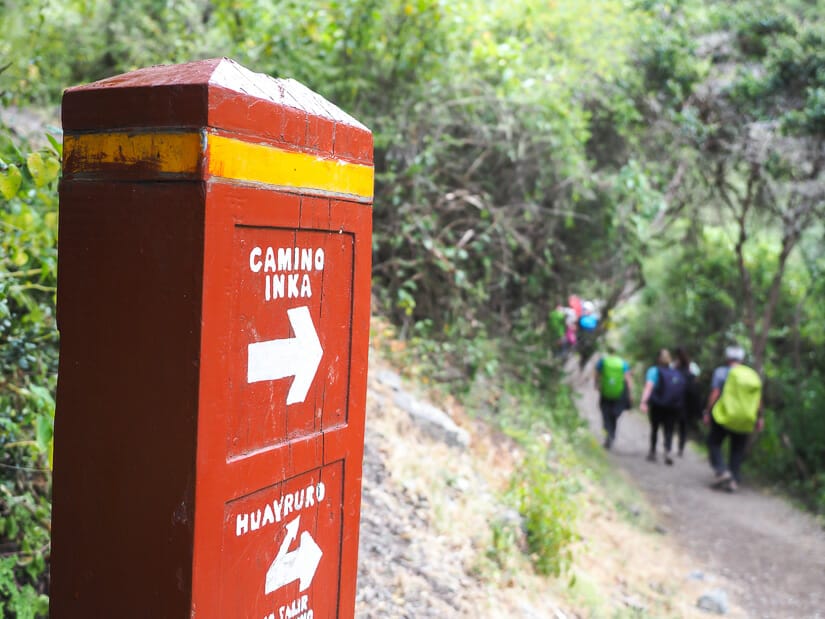
There are several options for hiking to Machu Picchu. These include the 2-day, 4-day, and 5-day Inca Trails, as well as Salcantay and Lares treks that end at Machu Picchu. Here’s a quick summary of each of those:
- 2-Day Inca Trail: You only hike for one day, including a visit to Wiñay Wayna, the most important ruins on the Inca Trail besides Machu Picchu. Then you see Machu Picchu from the Sun Gate, go to Aguas Calientes (the tourist town below Machu Picchu), sleep in a hotel there, then take a bus to Machu Picchu the next morning.
- 4-Day Inca Trail: The classic Inca Trail hike which I highly recommend, but it’s also the most popular, so requires the earliest booking.
- 5-Day Inca Trail: Like the classic Inca Trail, but with slightly shorter days of hiking, staying in different camps, and the last day finishes like the 2-Day Trail: you see Machu Picchu from the Sun Gate, then sleep in a hotel in Aguas Calients, and take a bus to Machu Picchu the next morning.
- Salcantay Trek to Machu Picchu: Salcantay is a totally different trek than the Inca Trail. You hike to Salcantay, a sacred mountain in the region. For treks that combine Salcantay and Machu Picchu, you basically just hike to Aguas Calientes at the end, then take the bus to Machu Picchu. Some treks combine Salcantay and the short (2-day) Inca Trail into a 6-day trek.
- Lares Trek to Machu Picchu: Like the above, this is a totally different trek, ending in Ollantaytambo, and they just tack on Machu Picchu at the end.
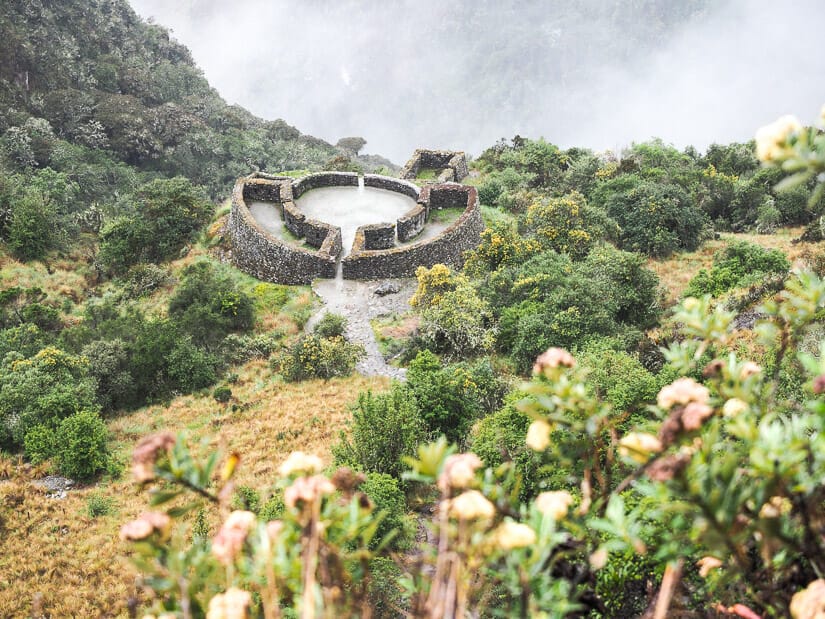
For me, the classic 4-day Inca Trail was the only logical choice. This is the way the Inca ruler himself would have originally arrived at Machu Picchu. The Inca Trail is a true pilgrimage – all the ruins along the hike (some of which are fantastic!) build trekkers up to the climax at the end. I wanted to work hard for my reward at the end, and I wanted to hike right to it.
For those who are short on time, or can’t/don’t want to hike for 4 solid days, I can see the appeal of the 2-day trek. It’s better than nothing, and I loved the Wiñay Wayna ruins, which are included. But for this once-in-a-lifetime experience, why not go all-in?
I also admit that I briefly considered the 5-day Inca Trail. I thought it might be nice to have it more spaced out. I also liked the idea that you get to see Machu Picchu twice – although the first time is only a view from a distance.
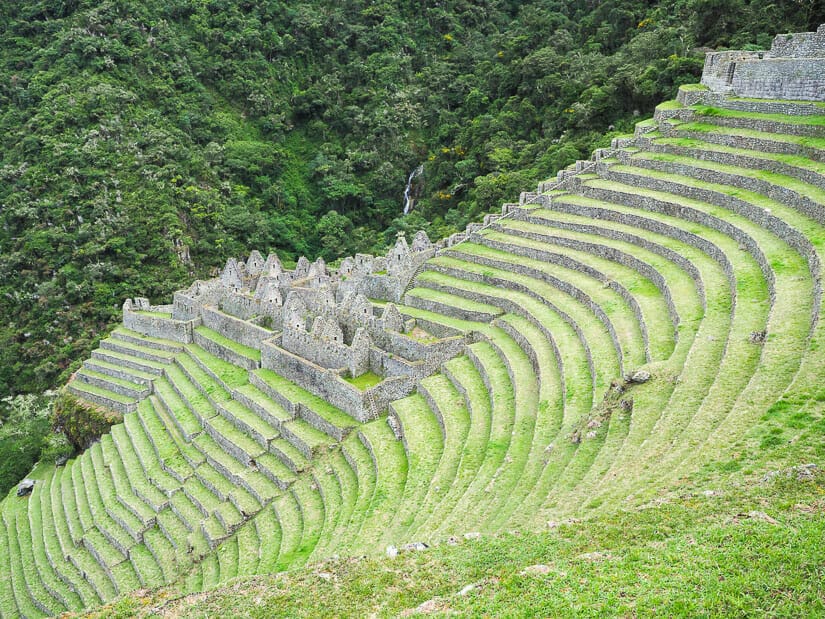
However, once I started inquiring to trekking companies, few of them availability for the 5-day trek, since it is much less popular than the 4-day trek. If you have a big group already, they would take you, but if you’re alone like me or just a couple, it might be harder to find a 5-day trekking group to join.
In the end, I’m glad I didn’t go with the 5-day trek, because they don’t get to hike in to Machu Picchu – they just ride a bus there on the final day.
I also didn’t want to do any of the “alternative treks” to the Inca Trail and then just add on a visit to Machu Picchu by bus at the end of it. Indeed, those other hikes in the region sound amazing, and I would like to do some of them on my next trip. But for my Machu Picchu experience, I just wanted the classic route, which has always been the most famous, and for so many reasons.
And, believe it or not, I actually ended up enjoying some of the ruins along the Inca Trail more than Machu Picchu itself. In part this was because of my disappointment about the rain at Machu Picchu, but more important, MP was just so damn crowded. At some ruins on the Inca Trail, I had them entirely to myself or just to our little hiking group!
Finding a Trekking Company
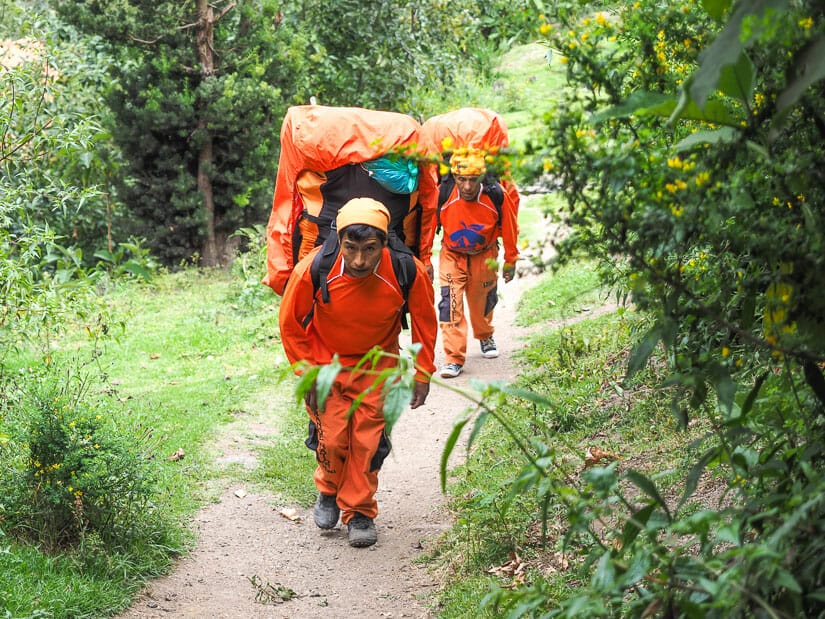
Once you’ve figured out when to go, and which trek you want to do, it’s time to choose a trekking company. And there are lots of them!
Doing the Inca Trail through a company is mandatory. You can’t do the Inca Trail on your own. (However, you are allowed to visit Machu Picchu on your own, contrary to what many guides there will try to tell you!)
I’m not going to give you a list of all the companies doing the Inca Trail, or the pluses and minuses of each one. I’m only going to share my personal experience.
After I knew my dates, I started researching these companies, reading reviews, and reached out to a few for quotes. One tip: for virtually all of them, you’ll find mostly good reviews, and always a few bad ones. For the bad ones, it’s always important to read between the lines, keep in mind that shit sometimes just happens, and also consider how old those reviews are.
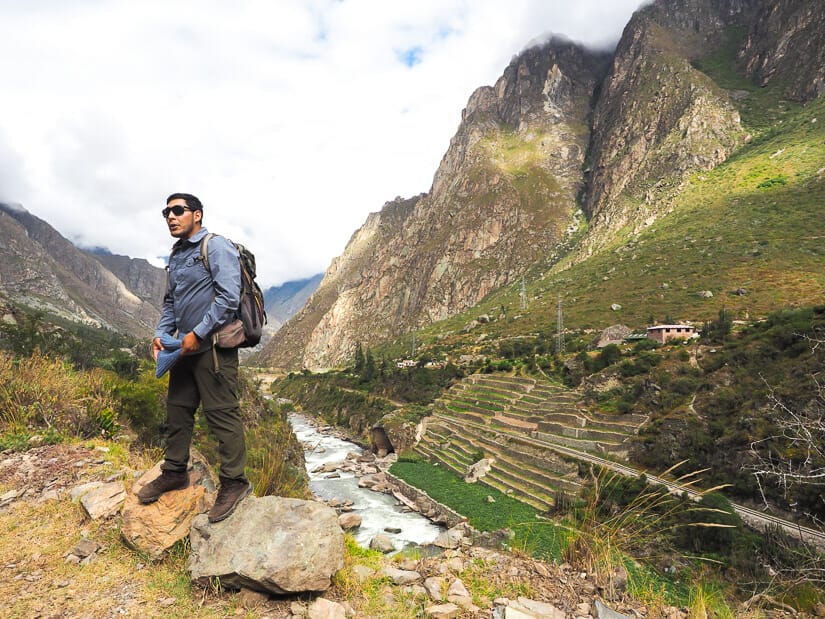
As I started researching trekking companies, I found that most of them seemed to make similar claims, especially about treating their porters well. In fact, practices out on the trail are now regulated. For example, there’s a weight limit of 25 kilograms for each porter, and they really check this on the trail.
And those horror stories about porters trekking in sandals? Well, one elderly porter on our crew was actually wearing sandals, because that is how he’d trekked his whole life and he insisted on it.
Out on the Inca Trail, I found that each of the main trekking companies seemed to provide similarly high-quality clothing and gear for their porters.
Each company has their own signature bright color. They even have nicknames for each other related to these colors. We (Sam Travel) were in orange and dubbed the “Orange Crushers.” A green group was nicknamed Green Machine, yellow group the Minions, and so on. The well-known G Adventures was in purple.

In the end, after a fair bit (but not crazy amount) of review-reading and research, I went with Sam Travel Peru for six reasons:
- They were the most responsive to my queries, answering my emails the fastest and with the most detail. Other companies took days to reply, but Sam usually replied in hours.
- They were at the lower end of the price range.
- They had very good reviews, sitting at the top spot on TripAdvisor (though I would come to learn that they really encourage their clients to post on TripAdvisor).
- I liked their 4-day itinerary choices, which included an earlier start on Day 1 to make it to a better camp, and a longer Day 2 in favor of a shorter Day 3 (this indirectly resulted in my single favorite experience on the whole trek – see Day 3 in my Inca Trail Day-by-Day article). If you care about such details, you can spend some time studying the Inca Trail route like I did, then evaluate which itineraries and camps each company takes.
- The company is indigenous run – it was founded and is still run someone who himself started out as a porter! SAM is actually an acronym of his name, Saul Alvarez Montalvo.
- Sam Travel takes small groups, with a maximum of 8 trekkers. This is how many we had, and I found it to be the perfect size.
How Early to Book
How early should you start doing this? Most online guides recommend booking your Inca Trail hike 6–8 months in advance. I tend to book my trips very early, so I did it a full year in advance, and that wasn’t too early.
Generally speaking, you’ll want to book even earlier if you’re planning to travel in peak season (July or August). I would say 8 months to 1 year in advance is not a bad idea. For May–June or September–November, 6 to 8 months is probably sufficient. And for the rainy season, booking far in advance is even less urgent. But if you’re a solo trekker, then finding another group to join could be more difficult, and you may have to be more flexible with your dates.
Having said all that, depending on what’s going on in Peru, things can change.
For example, with the political instability in Peru in early 2023, around 90% of people canceled their Peru trips in the coming months. This meant that most tourist-oriented businesses in Peru were desperate for business, and you probably could have found something even last minute.
As of mid-2023, the tourist numbers are still way down in Peru, but they are starting to recover.
How Much Will It Cost?

When I started researching companies, I found that the cost varied quite a bit. I got quotes ranging from $600 to 1200 as the base price. And this was for pretty much the same thing – the reviews, and what was provided by companies at the lower end didn’t seem much different than for those at the higher end of the price range.
As for the price, here is exactly what I paid. Please note, these prices could of course change in the future, change by season, or depend on the size of your group. I’m also going to add tips here, because this is a necessary cost. All prices below are in USD.
- Base Price for Inca 4-Day Trail $657
- Additional MP ticket for Huayna Picchu trail (optional, see below for details) $75
- Sleeping bag and air mattress rental $40
- Single tent (I was solo but got a double tent. This price might be lower if you share with someone) $30
- Single hiking pole rental (I only asked for one) $10
- Tips (this figure can vary) $100
Total $912
This price included all meals and drinking water on the trek, porters, guide, camp set up, entrance fees, tour at Machu Picchu, bus to Aguas Calientes on the final day, and transportation to and from Cusco.
Essentially, I didn’t have to spend any money for those four days, unless I wanted to buy an extra drink or snack on the trail (including a beer at camp on Day 1!)
Please note that if you are willing to pay more money for more luxury, the sky is the limit. Our guide David told us about how, a few months earlier, he had escorted an elderly woman on a luxury trip. It came with hot shower, Champagne, and so on. She had the same number of porters than our group of 8 did!
Is the Inca Trail expensive?
If you’re coming from abroad, and going to Peru mainly just to do the Inca Trail and see Machu Picchu, the costs of the Inca Trail probably won’t seem too bad to you. You might even consider it a bargain.
However, if you are backpacking across South America and used to local prices there, this will mostly likely seem very expensive. It will probably be the priciest activity on your entire trip.
In our hiking group, there was one couple who were like this, and they mentioned several times how expensive the hike was. When it came to tipping, they were also less keen to give as much as the rest of the group was.
Overall, some people say that Machu Picchu as a whole is a big money grab. For example, if you buy a bus ticket from Aguas Calientes to Machu Picchu, which is only a 20-minute ride, it costs USD 24, which is insanely expensive for Peru. Similarly, the tourist class on the Machu Picchu train, the only one you’re allowed to take, starts at $140 (Peruvians only pay $6 in the local class).
But you want to see Machu Picchu, right? So you have to pay. Note that you can actually skip these two fees by hiking in to Aguas Calientes, and hiking up to Machu Picchu. But for those hiking the Inca Trail, the bus and train (one-way, at the end of your hike) are usually included in your base price.
USD or Soles?
As for how to pay, you may be wondering whether you should pay in USD or soles. For Sam Travel, I paid a $275 down payment when I first booked. I was able to pay by credit card, but there was a fee to do so.
For the rest, I paid in USD cash on the first day. I brought this cash from home to avoid the extravagant ATM fees in Peru. I also had the option to pay by credit card at their office, but with a 5.5% added fee.
You wouldn’t want to pay for the whole tour in soles, because you’ll either have to lose money when you exchange your home currency to soles, or lose money in ATM fees. You’d have to take out soles multiple times, because the maximum withdrawal amounts are really low in Peru.
How much to tip?
As for tips, it is better to tip in soles. Soles is what locals mostly use, so if you give them USD, they will have to exchange it first. You will need to give the tip to the porters and chefs on the 3rd night of your trek, so you need to prepare this cash in advance. Then you will give a tip to the guide on the last day.
For our group, our guide actually told us how much we should each tip to the porters/chefs during the briefing, one day before the first day of the trek. We found it a little awkward that he told us how much to tip.
I personally wish they would just include this in their base price if it is going to be a set amount. Our group also found it awkward and difficult to decide together how much to tip the guide himself at the end.
In the end, I spent about US$100 on tips (but paid in soles equivalent). This was more than 10% of the total cost of the trek ($812 before tips), so I feel it was a bit too much.
Preparing Clothing & Gear
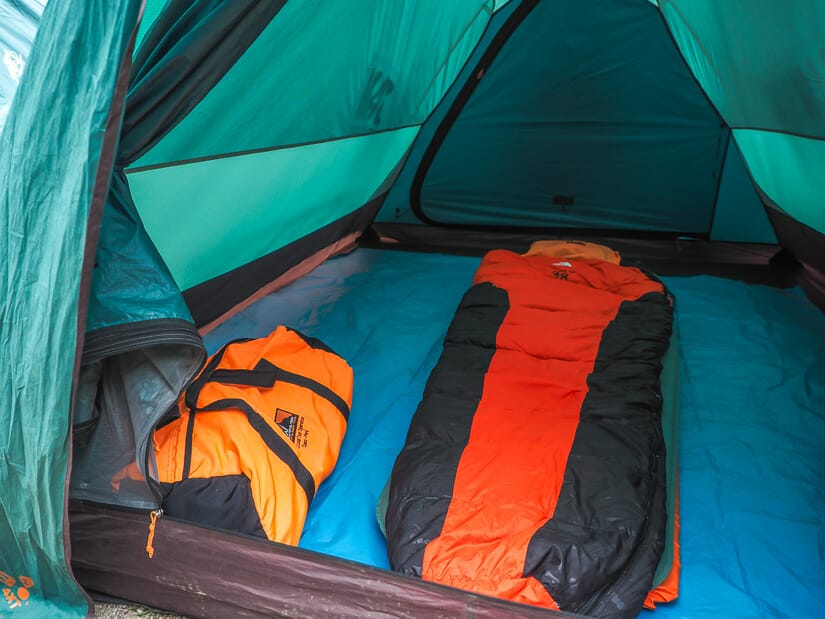
After my trip was fully booked, I started to think about what clothing and gear to prepare. I’m not going to go into so much detail here, because this article is not meant to be a packing list (you can just Google search to find those). Also, I find that preferred gear and clothing varies quite a bit by person.
But here are some general tips:
- You kind of need to prepare for all seasons. No matter when you go, it will sometimes be hot and summer-like. Even low 20s Celsius, or upper 60s to mid 70s Farenheit, can feel quite hot at high altitude, and it’s easier to burn. And it will sometimes be very cold and almost winter-like, especially on the high passes and at camp at night.
- Everything you bring should be as light-weight as possible.
- Avoid using brand new items (especially hiking boots) for the hike. That’s just a recipe for blisters.
- The trekking company will provide all bedding, drinking water, food and snacks, and you can rent hiking poles from them if you need them. Sam Travel also provided a rain poncho to each of us and plastic bag to make sure our items inside the duffel bag stayed dry while the porter carries them.
- You will need a day pack for any items you need while hiking, including water. The recommended size is 30 L – browse some of the best backpacks of this size here. Any items you will only need at night/camp will be put into a duffel bag. The company provides one duffel bag per hiker, and you can only put a maximum of 4 kilograms into it. They also need to put your sleeping bag and mattress into it, so it can’t be full.
- You will most likely have to leave your main luggage behind, plus any items you don’t need for the trek. You can either leave it at your hotel in Cusco/Ollantaytambo, or leave it with the trekking company office to pick up after your trek. There is a luggage size limit on the train from Machu Picchu back to Cusco/Ollantaytambo, and there’s no point hauling luggage on the trek that isn’t needed.
My packing list
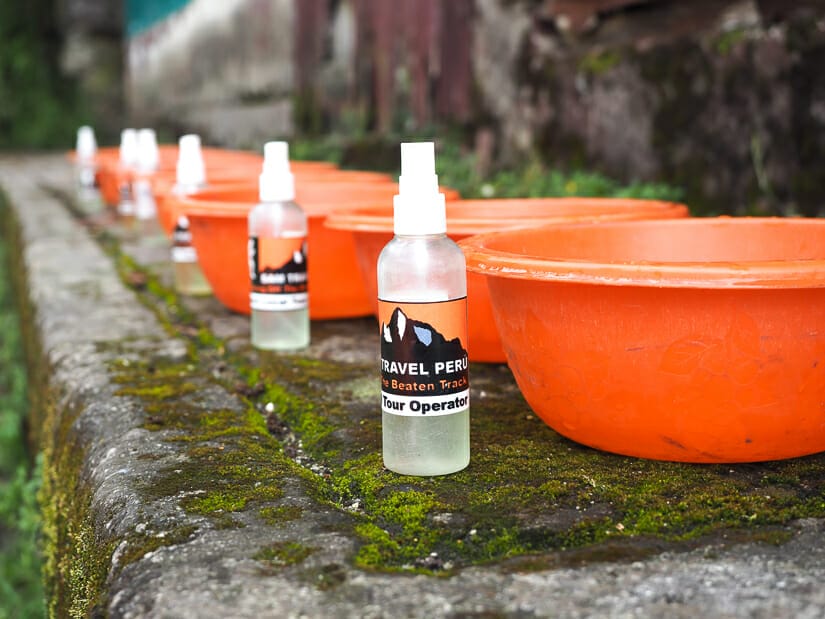
Your trekking company should give you a recommended packing list, and these will vary by company depending on which items they provide. Here is Sam’s recommended packing list for the Inca Trail.
Here are some items that I prepared before my trip:
- Small day bag for the hike.
- Extra camera batteries and two phone battery packs.
- 1.5 litre water bottle.
- Hiking pants that can unzip into shorts.
- Super light weight insulated puffer jacket like this one.
- Comfortable hiking boots that I’d used before.
- Thermal underwear and shirt, plus T-shirts
- Good hat and sunglasses
- Undies and socks (bring more socks than you think you need)
- Headlamp for using bathrooms at night and packing up your things before sunrise.
- Sunscreen and insect repellant (stay below 100 ml for liquids on airplane)
- Blister pads and other first aid items
- Diarrhea and altitude medication (see below)
- Zip-lock bags for passport and important items
- Outdoor wet wipes (AKA my daily shower) and toilet paper
Medications to Prepare

Besides any personal medication you may need, I also recommend bringing something for diarrhea and for altitude.
For diarrhea, I’ve experienced both mild (“travelers’ diarrhea”) and more extreme cases (“food poisoning”) numerous times in different parts of the world.
For mild diarrhea, which is practically inevitable at some point during your trip, I recommend something like Imodium (Loperamide). This will basically just stop you from crapping yourself, or having to use some really grotty bathrooms (or the bush) on your hike. And yes, there was one day on the Inca Trail when I was very thankful to have this on me.
I also recommend that you prepare some electrolyte/hydration salts to rehydrate in case you get diarrhea. Gatorade is also available on Day 1 and 2 on the trail.
In cases of more serious diarrhea, usually caused by bacterial infection, prescribed medicine will be required. I always visit my doctor before such a trip and receive Ciprofloxacin. Luckily I didn’t have to use it on the Inca Trail or during this Peru trip, but it’s a great idea to have it on you just in case. Speak to your doctor about what’s best for you.
Secondly, I strongly suggest that you also ask your doctor for Diamox (Acetazolamide). This is a prescribed medication that helps your adjust to the elevation and decrease symptoms of altitude sickness. You start taking it a day before you go to high altitude and as long as you are up there.
Sensitivity to altitude varies by individual. I know from past experiences that I am more sensitive to it. So I took Diamiox for my first few days after arriving in the Sacred Valley, then stopped once I was acclimatized. Then I took it again for my first few days of the Inca Trail, when we went to the highest altitudes (including 4200 meter / 13,780 foot Dead Woman’s Pass).
Other members of my hiking group had no issue with the altitude. But one woman was suffering mild symptoms the whole trek, despite taking Diamox AND being in the region for a week before the trek.
Even with the Diamox, I still felt mild symptoms like headache and lethargy on my first two days in the Sacred Valley. I’m sure it would have been worse if I had not taken it. If you’re planning to stay in Cusco first, which is even higher, than this is even more important. This is why I strongly suggest to stay in Pisac or Ollantaytambo in the Sacred Valley first, right after you fly in to Cusco.
Note that they also sell pills in Peru called “Soroche” (altitude sickness) pills. However, these are not as good as Diamox. Locals also chew coca leaves or drink coca tea, but this is also not as effective. To minimize the chance of spoiling your trip, I recommend getting Diamox before you go.
I was able to get both Diamox and Ciprofloxacin in a single doctor’s visit.
The altitude on this trek is no joke. During our trek, we saw one young woman who was seriously suffering and had to be carried down for many hours in a stretcher. Before embarking on the trek, it is essential that you acclimatize in Cusco or the Sacred Valley for at least a few days.
Don’t plan anything too strenuous for the first day or two, then try to start with some smaller hikes and start building your way up (even just walking around Cusco often involves lots of stairs).
Preparing Physically

Besides giving yourself at least a few days in your travel schedule to acclimatize to the altitude in the Sacred Valley, I recommend that you do some physical training in the months leading up to your trip. This of course will depend on what kind of shape you’re already in.
Personally, I have lots of hiking experience, but I was not in great shape before my trip. I work at home, so I do a lot of sitting. I’ve got two young kids and my life is always very busy, so I almost never make time for exercise.
For six months leading up to my Peru trip, I changed that. I started working out and doing sports or physical activities several times per week. In the final month, I especially focused on lots of stairs, and would carry my day pack (including full water bottle) while doing it.
I really think that this training set me up for success on the Inca Trail. I’ve had a bad knee for years, and the original injury was on a hike (going downhill). But my knee held up fine on this trek, thanks I think that all the training.
Also, I planned extra time in the Sacred Valley before I did the Inca Trail. I actually stayed in Pisac for the first four nights, then Ollantaytambo for another four nights. Then I saved the higher altitude places like Cusco, Chinchero, and Moray for after the trek. In total, I spent almost 3 weeks in the region.
If you have that kind of time to work with, then great! I realize most visitors don’t allot that much time to the area. But I still suggest putting as many days as you can before you do the Inca Trail. The first two days might be a write-off if you’re feeling the altitude. Then you can use a few more days to do some easier hikes.
In the time I had, I did several day hikes around Pisac and Ollantaytambo, including the famous Pisac ruins and Ollantaytambo ruins, as well as several other Cusco area ruins. Combined with the training I had done before my trip, I think these hikes made a huge difference in preparing me for the Inca Trail.
The Inca Trail was still tough, don’t get me wrong! But I think I had it many times better than if I hadn’t done any training or smaller hikes in the days leading up to it.
Researching the Route and Ruins

This is not a necessary step. You don’t really have to know anything about the Inca Trail route or the sights and ruins you’ll be seeing along it. That’s what the guide is for!
However, if you’re a big travel planner like I am, some advance research will go a long way.
Your trekking company’s website most likely already has lots of information about the route, sights, walking times, camps, and so on. Sam Travel publishes all that info about the 4-day Inca Trail here. This was my starting point for research.
From there, I went to other sources to read more about the individual ruins, camps, and so on. Also, when comparing Sam’s info to other websites and maps, I did find some differences or discrepancies. There are a lot of trekking companies out there publishing various maps and guides to the hike, and I have say that some information out there is wrong or outdated. So comparing multiple sources is a good idea.
Learning about the ruins is good because not all guides are great. Our guide, David, was excellent, and had encyclopedic knowledge. But he really focused on certain topics and sometimes didn’t cover ones I would have preferred. You can start off by learning about the main ruins on the Inca Trail here.
I also highly recommend these two books:
Turn Right at Machu Picchu by Mark Adams. Mark is a city slicker with an office job (rather than the adventure type who usually write this kind of book and make everything sound easy). He embarks on a quest to walk in the footsteps of Hiram Bingham, the scientific discoverer of Machu Picchu.
I really loved this book because I identified with the author. He does several hikes but the book culminates with the Inca Trail. There’s a lot of factual and historical info, but it’s also fun and real.
Another is The Machu Picchu Guidebook by archaeologists Ruth M. Wright and Alfredo Valencia Zegarra. This is the most detailed guide to Machu Picchu out there, for serious ruins geeks who want to know exactly what every area and structure at Machu Picchu is, including detailed maps of each conjunto (section).
This book was far better and more detailed than the actual tour we received at MP. The only thing to mention is that some things described in the book and not accessible on today’s MP circuits, so you’ll have to do a lot of comparing with the MP circuit maps. Use my guide to the Machu Picchu circuits in conjunction with this book and you will be set to visit Machu Picchu without a guide!
The book doesn’t cover the Inca Trail, but it does include a few ruins on it.
Understanding the Circuits at Machu Picchu
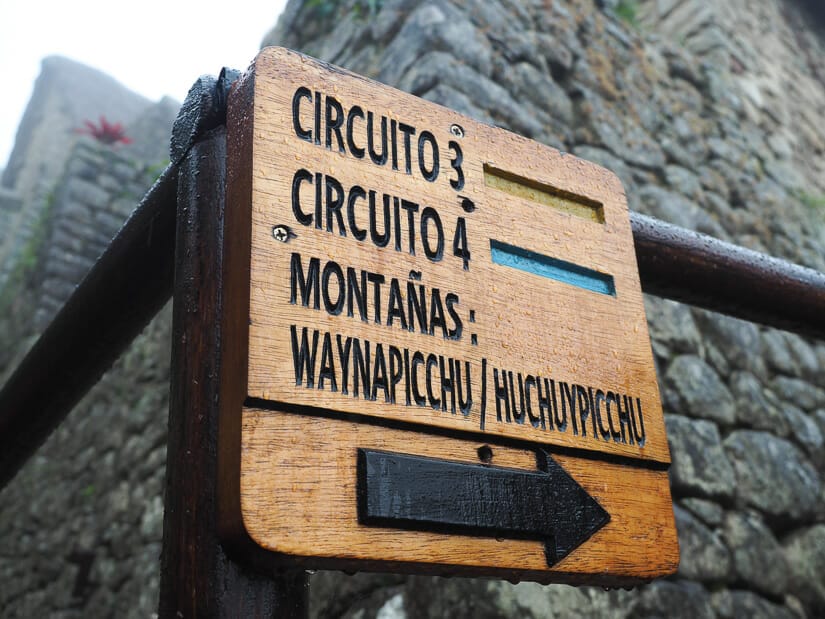
I love travel planning. I tend to do huge amounts of research on every detail of my trip. In part, this is because I’m often writing articles about these trips to publish here on my website.
One detail about my Inca Trail and Machu Picchu visit that started to concern me was the new circuits at Machu Picchu. These circuits were set up a few years ago to control the flow of visitors at Machu Picchu. It is one of the ways that the site is trying to manage overtourism. This is understandable, as even with the current cap of 4500 daily visitors, it feels quite crowded there.
I noticed on the Sam Travel website that we would do Circuit 3 once we arrived at Machu Picchu. Once I started to research the five different circuits in detail, I came to realize that Circuit 3 was not the best one. It actually missed out on a few of the most famous places at Machu Picchu (including Inca Bridge, the main Entrance Gate, the Sacred Plaza, Temple of Three Windows, and Intihuatana).
Even with my second Machu Picchu ticket (for hiking up Huayna Picchu, the iconic mountain behind MP), I would still miss those spots. I wondered why Sam Travel would take us on this inferior Circuit.
Because I spent so much time researching and figuring out the circuits at Machu Picchu, I decided to publish this super detailed guide to the Machu Picchu Circuits, including how to choose the best one. Hopefully this will save you lots of time doing the research yourself!
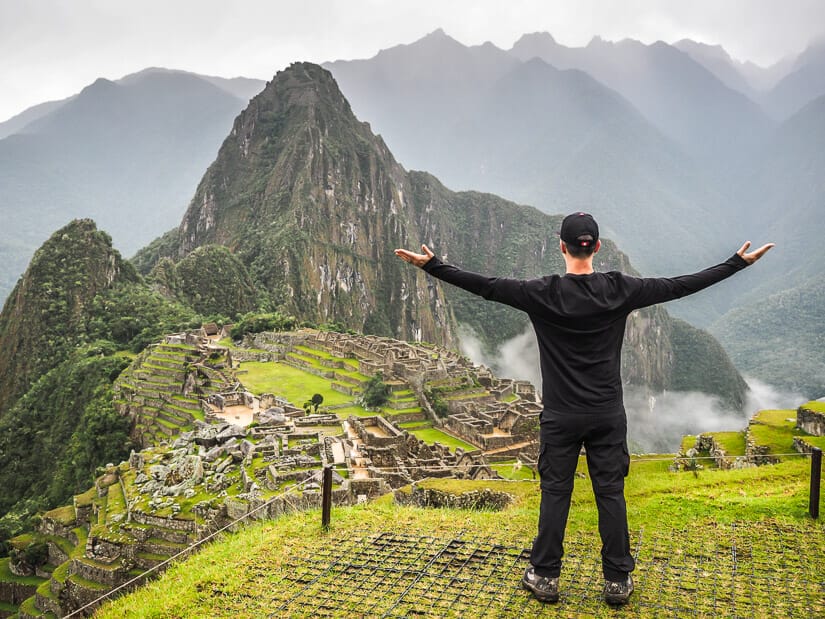
It turns out that this is not their choice – everyone entering Machu Picchu via the Inca 4-day trail has to do Circuit 3. Although Circuit 3 doesn’t even include the classic Machu Picchu viewpoint, we would get to see that immediately upon arriving at the site.
So, if you’re doing the Inca Trail 4-day trek, and you really want to see all the famous spots at Machu Picchu, I highly recommend that you buy an additional ticket for Circuit 2 – the best and most complete one. Choose “Puente Inka – Circuit 2” for the ultimate one. This is the complete Circuit 2, plus an additional side hike to Inca Bridge.
You could buy this ticket for the same day, and do this circuit on your own after your Circuit 3 ends. However, note that Machu Picchu is busiest at this time of day. A better option is to buy a Circuit 2 ticket for the next morning.
Then you can spend a night in Aguas Calientes, and come back for your second (and more complete) visit the next day. This also gives you two chances to enjoy good weather for your famous Machu Picchu view – increasing your chances is good, because it is often clouded over in the morning.
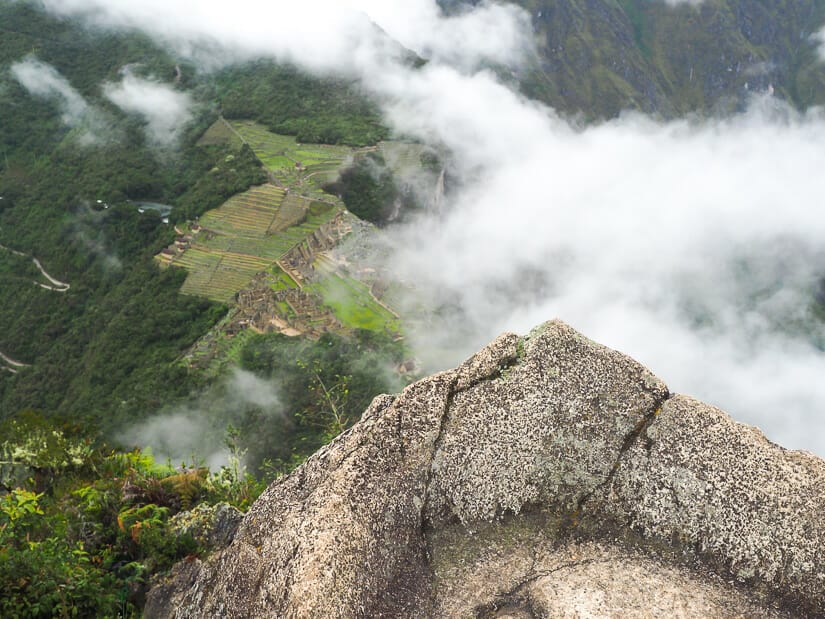
So, in the end, I actually had 3 Machu Picchu tickets! One was Circuit 3, which was included in my Inca Trail price. We did this tour upon arrival and it was led by my Inca Trail guide. The second was Circuit 4, which is for hiking Huayna Picchu. I did this by myself after our tour, but Sam Travel helped me to purchase the ticket for an additional cost.
And finally, I bought a Puente Inka Circuit 2 ticket by myself on the official website. I did this the following day on my own – doing three Machu Picchu circuits in one day would have been too much, especially after waking up at 3 AM that morning!
No matter what you choose, you must communicate with your trekking company about the details so that they can arrange whatever tickets you need. They also need to book your train ticket back to Ollantaytambo or Cusco at the correct time if you choose to stay in Aguas Calientes for one or more nights like I did.
So that pretty much brings us to the Inca Trail hike itself! Please click here to read my super detailed day-by-day guide to the 4-day Inca Trail hike!

